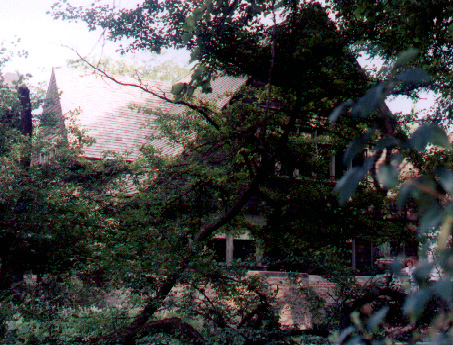 Book Notes: Bulldozer in the Countryside, Adam Rome; 2001.
Book Notes: Bulldozer in the Countryside, Adam Rome; 2001.


"In 1950....Four of Garnett's images became iconic. The first was a bulldozed landscape....In the second photograph, the tract had dozens of foundations in lines stretching infinitely beyond the frame."
"But the tract was about to become a neighborhood."
p. 1
- * Introduction. 1-14.
- *1. Levitt’s progress,the rise of the suburban-industrial complex. 15-44.
- * 2. From the solar house to the all-electric home: the postwar debates over heating & cooling. 45-86.
- * 3. Septic-tank suburbia: the problem of waste disposal at the metropolitan fringe. 87-118.
- * 4. Open space: the first protests against the bulldozed landscape. 119-152.
- * 5. Where not to build: the campaigns to protect wetlands, hillsides, and floodplains. 153-188.
- * 6. Water, soil, and wildlife: the federal critiques of tract-house development. 189-220.
- * 7. Toward a land ethic: the quiet revolution in land-use regulation. 221-254.
- * Conclusion. 255-270.


"By making the United States a nation of homeowners, the boomers argued, tract housing would help lay the foundation for a booming mass consumption economy."
p. 3.



land, water, and vegetation dependent wildlife all were supplanted by the largest land boom in the brief nation's history.
"But the names evidenced a brutal contradiction. To create tracts of houses, builders in the 1950s and 1960s routinely destroyed the meadows, woods, and hills they honored in their place names."
"…a story of how Americans tried to resolve that contradiction."
p. 13.

Compelling argument
The single-family home construction industry
"because tract housing caused a remarkably broad range of environmental problems, including almost all the problems . . . . explains much about how the concerns of environmentalists changed over time."
The homebuilding story contributes to a more complex understanding of 'the environmental opposition. . . . economic interests at the heart of the resistance to the movement . . . . "
pp. 6.
 The suburb of Chicago: Oak Park, Illinois.
The suburb of Chicago: Oak Park, Illinois.
1. "Though a growing concern for the loss of wilderness obviously contributed to the rise of environmentalism, the movement also was response to environmental change at the "edges of the nation's cities."
pp. 7-8.
2. "Though the environmental movement differed in some key respects from the conservation movement the ideas of the conservationists nevertheless shaped environmental thought well into the 1960s."
pp. 8-9.
3. "Though ecologists played a prominent role as advocates for environmental activism, other scientific and technical professionals were also important in drawing attention to environmental problems."
pp. 9-10.
4."Though some federal agencies repeatedly battled with environmentalists, other federal agencies were instrumental in putting environmental problems on the public agenda."
p.10.
5. Though a well-organized anti-environmental movement came out of a struggle over public lands in the West, the effort to control urban and suburban development also led to a powerful anti-environmental movement – the movement to defend "property rights."
". . . the property-rights cause . . . . the issue was rooted in the debates of the late 1960s and early 1970s over lands use in the fast-growing cities and suburbs."
p.11.
6. "Though environmentalism was partly a form of consumer politics, the consumer mindset has limited the movement in crucial ways."
p. 12.

I. Levitt’s Progress: The Rise of the Suburban Industrial Complex
Case study is the promise and meaning of Levittown
Macroeconomic importance of homebuilding
Laying the foundations for a Consumer Society
The model of this new form of settlement was in Hicksville, LI, New York:
1950
10,600 homes on 1,200 acres of land, old potato growing fields
Levittown was a city of 40,000 people in rural, Nassau County.
“The results were astonishing”
“Instead of building one house at a time, the new leaders in the housing industry had begun to use factory-like methods of mass production.”
industrial standardizations and integrated approach
15
“methods to produce house quickly and cheaply.”
16
“probably the best value currently on the market.” life magazine, proclaimed.
17
Case study
Levittown, as an example of mass production and the rise of the suburban-industrial complex
Macroeconomic importance of homebuilding
laying the foundations for a Consumer Society dependent on consumption of water energy & landscape
Mass production
FHA loan guarantees
Zoning from the Department of Commerce (1928, model zoning act) to segregate uses
“But the state of the nation’s housing did not become a national issue until 1921, when Herbert Hoover became Secretary of Commerce, Hoover’s interest in housing went beyond the conditions of tenements and slums. He believed the widespread home ownership was ‘the foundation of a sound economy and social system,’ and he argued that the structure of the housing industry made home ownership impossible…”
p. 19.
Economic stagnation was due to:
1) Too many renters
2) Too many inefficiencies in the home building industry
Public-private partnership to promote home ownership –
Model zoning ordinance 1920s separated one sort of use, commercial from another: residential.
Success was in 1925: 937,000 housing starts
1. Hoover in the height of the depression in 1931, called for easier home mortgages and “call for mass-produced housing” – revitalize building!
2. One third of the nation in 1920s boom period lived in substandard housing
3. Edith Wood, social progressive reformer, called for direct government action
pp. 19-25.
Any statistical data on cities in USA.
"By 1950, ...a number of people had already become concerned about the energy-wasting design of the typical postwar home.
p. 43.
There "was a dramatic increase in energy consumption."
p. 86.


